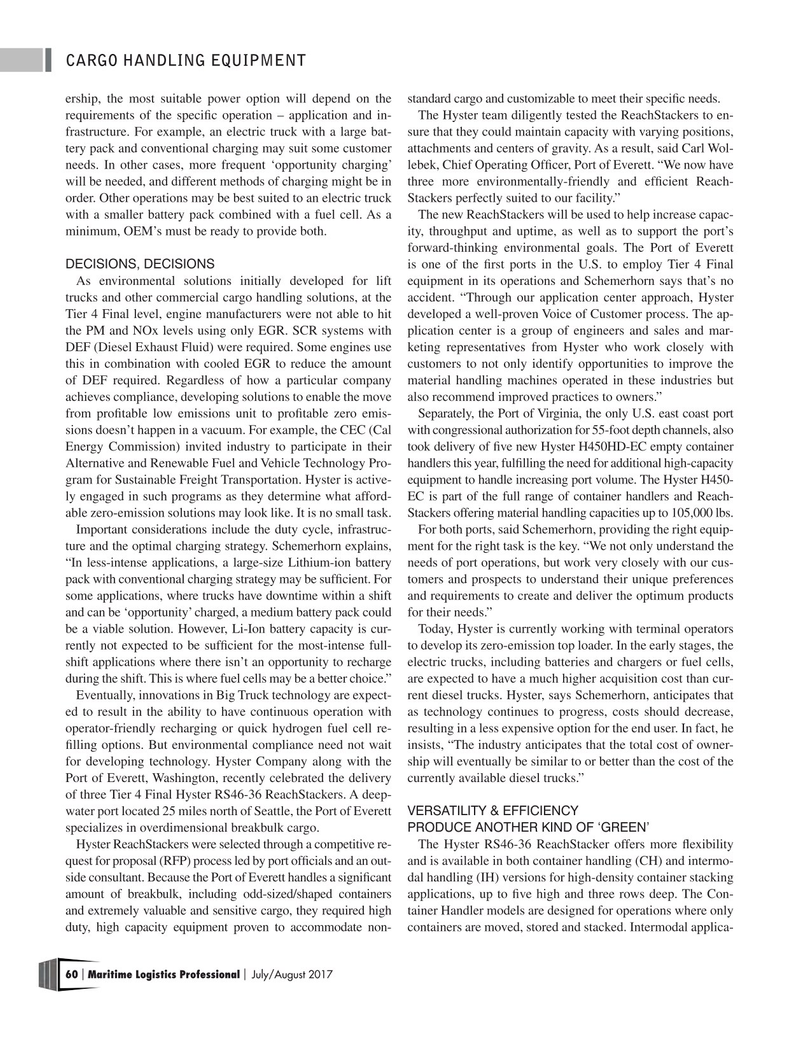
Page 60: of Maritime Logistics Professional Magazine (Jul/Aug 2017)
PORTS & INFRASTRUCTURE
Read this page in Pdf, Flash or Html5 edition of Jul/Aug 2017 Maritime Logistics Professional Magazine
CARGO HANDLING EQUIPMENT ership, the most suitable power option will depend on the standard cargo and customizable to meet their specifc needs.
requirements of the specifc operation – application and in- The Hyster team diligently tested the ReachStackers to en- frastructure. For example, an electric truck with a large bat- sure that they could maintain capacity with varying positions, tery pack and conventional charging may suit some customer attachments and centers of gravity. As a result, said Carl Wol- needs. In other cases, more frequent ‘opportunity charging’ lebek, Chief Operating Offcer, Port of Everett. “We now have will be needed, and different methods of charging might be in three more environmentally-friendly and effcient Reach- order. Other operations may be best suited to an electric truck Stackers perfectly suited to our facility.” with a smaller battery pack combined with a fuel cell. As a The new ReachStackers will be used to help increase capac- minimum, OEM’s must be ready to provide both. ity, throughput and uptime, as well as to support the port’s forward-thinking environmental goals. The Port of Everett
DECISIONS, DECISIONS is one of the frst ports in the U.S. to employ Tier 4 Final
As environmental solutions initially developed for lift equipment in its operations and Schemerhorn says that’s no trucks and other commercial cargo handling solutions, at the accident. “Through our application center approach, Hyster
Tier 4 Final level, engine manufacturers were not able to hit developed a well-proven Voice of Customer process. The ap- the PM and NOx levels using only EGR. SCR systems with plication center is a group of engineers and sales and mar-
DEF (Diesel Exhaust Fluid) were required. Some engines use keting representatives from Hyster who work closely with this in combination with cooled EGR to reduce the amount customers to not only identify opportunities to improve the of DEF required. Regardless of how a particular company material handling machines operated in these industries but achieves compliance, developing solutions to enable the move also recommend improved practices to owners.” from proftable low emissions unit to proftable zero emis- Separately, the Port of Virginia, the only U.S. east coast port sions doesn’t happen in a vacuum. For example, the CEC (Cal with congressional authorization for 55-foot depth channels, also
Energy Commission) invited industry to participate in their took delivery of fve new Hyster H450HD-EC empty container
Alternative and Renewable Fuel and Vehicle Technology Pro- handlers this year, fulflling the need for additional high-capacity gram for Sustainable Freight Transportation. Hyster is active- equipment to handle increasing port volume. The Hyster H450- ly engaged in such programs as they determine what afford- EC is part of the full range of container handlers and Reach- able zero-emission solutions may look like. It is no small task. Stackers offering material handling capacities up to 105,000 lbs.
Important considerations include the duty cycle, infrastruc- For both ports, said Schemerhorn, providing the right equip- ture and the optimal charging strategy. Schemerhorn explains, ment for the right task is the key. “We not only understand the “In less-intense applications, a large-size Lithium-ion battery needs of port operations, but work very closely with our cus- pack with conventional charging strategy may be suffcient. For tomers and prospects to understand their unique preferences some applications, where trucks have downtime within a shift and requirements to create and deliver the optimum products and can be ‘opportunity’ charged, a medium battery pack could for their needs.” be a viable solution. However, Li-Ion battery capacity is cur- Today, Hyster is currently working with terminal operators rently not expected to be suffcient for the most-intense full- to develop its zero-emission top loader. In the early stages, the shift applications where there isn’t an opportunity to recharge electric trucks, including batteries and chargers or fuel cells, during the shift. This is where fuel cells may be a better choice.” are expected to have a much higher acquisition cost than cur-
Eventually, innovations in Big Truck technology are expect- rent diesel trucks. Hyster, says Schemerhorn, anticipates that ed to result in the ability to have continuous operation with as technology continues to progress, costs should decrease, operator-friendly recharging or quick hydrogen fuel cell re- resulting in a less expensive option for the end user. In fact, he flling options. But environmental compliance need not wait insists, “The industry anticipates that the total cost of owner- for developing technology. Hyster Company along with the ship will eventually be similar to or better than the cost of the
Port of Everett, Washington, recently celebrated the delivery currently available diesel trucks.” of three Tier 4 Final Hyster RS46-36 ReachStackers. A deep- water port located 25 miles north of Seattle, the Port of Everett VERSATILITY & EFFICIENCY specializes in overdimensional breakbulk cargo. PRODUCE ANOTHER KIND OF ‘GREEN’
Hyster ReachStackers were selected through a competitive re- The Hyster RS46-36 ReachStacker offers more fexibility quest for proposal (RFP) process led by port offcials and an out- and is available in both container handling (CH) and intermo- side consultant. Because the Port of Everett handles a signifcant dal handling (IH) versions for high-density container stacking amount of breakbulk, including odd-sized/shaped containers applications, up to fve high and three rows deep. The Con- and extremely valuable and sensitive cargo, they required high tainer Handler models are designed for operations where only duty, high capacity equipment proven to accommodate non- containers are moved, stored and stacked. Intermodal applica- 60 Maritime Logistics Professional July/August 2017 | |

 59
59

 61
61
